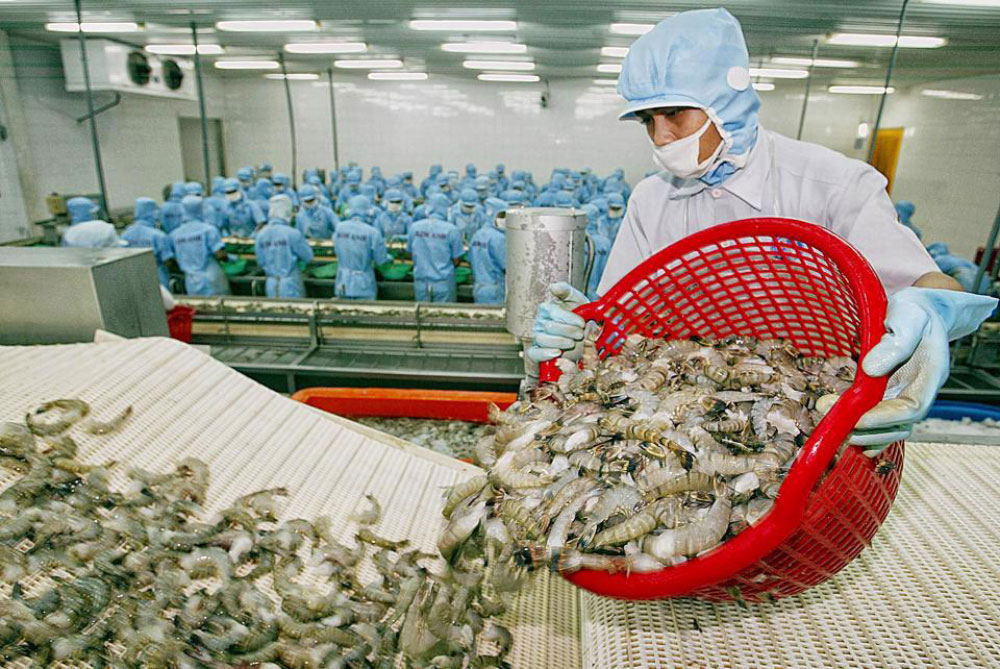Vietnam Seafood
Vietnam’s Shrimp exports in the first half of 2025 grow positively but face risks from the US Market
In the first half of 2025, Vietnam’s shrimp exports reached over USD 2 billion, a 27% increase compared to the same period in 2024. Whiteleg shrimp accounted for the highest proportion at 62.1%, followed by other shrimp species (27.4%) and black tiger shrimp (10.5%). Notably, other shrimp species saw a remarkable growth of 124%.
Growth in key markets
By market, China & Hong Kong rose to the top position with nearly USD 595 million in export value, up 81% year-on-year. The recovery in consumer demand, strong summer demand, and high demand for Vietnamese lobster continued to make China the fastest-growing market.
The CPTPP market group also recorded positive results with a 38% increase. Among them, Japan (up 19%), Australia (5%), and Canada (6%) all posted solid growth. Japan remains the third-largest single market for Vietnamese shrimp, thanks to stable demand and strength in value-added (VA) shrimp products.
Exports to the EU rose by 16%, with countries such as Germany, Belgium, and France seeing double-digit growth. Vietnam’s shrimp exports to the EU continue to benefit from the EVFTA, while competitors like Indonesia and Thailand do not.
South Korea also stood out with a 14% increase due to stable demand and a traditional preference for deeply processed shrimp. Taiwan rose by 27%, indicating a strong ripple effect for Vietnamese shrimp in East Asia.
In contrast, the US market—once the leading destination for Vietnamese shrimp—showed clear signs of decline. Although total exports in the first six months reached USD 341 million (up 13% year-on-year), monthly data showed a downward trend: a sharp rise in May (+66%) as companies rushed shipments ahead of new tariffs, followed by a steep 37% drop in June.
The US becomes a high-risk market
Since April 2025, under President Donald Trump’s administration, the US has imposed a 10% reciprocal tariff on imports from most countries. In July, Vietnam’s rate was officially announced at 20% (effective from August 1). Additional risks include preliminary anti-dumping (AD) duties of over 35% and countervailing duties (CVD) expected by the end of the year.
These tariff factors have made the US market unstable and unpredictable. Although US shrimp imports rose by 24% in the first five months (by value), this was largely due to companies rushing orders before the tariffs took effect, not sustainable growth.
The three-pronged “tariff sword” has made many US importers cautious, while Vietnamese exporters struggle with pricing and production/shipping planning.
Domestic shrimp prices rise on demand and market sentiment
Domestically, the farm-gate price of whiteleg shrimp rose continuously in July, especially for larger commercial sizes like 30 and 40 pcs/kg. By week 29 (July 14–20, 2025), prices had increased by VND 5,000/kg for each type—an overall rise of VND 20,000/kg in just two weeks. The cause was higher factory buying prices to meet production timelines, along with positive sentiment as the US delayed its tariff implementation to August 1.
Black tiger shrimp prices also surged, especially for 20 pcs/kg size, reaching VND 201,000/kg—the highest level since the beginning of the year.

Export outlook for July and the second half of the year
In July, Vietnam’s shrimp exports are forecast to slow compared to May and June, as many “tariff-avoidance” orders were already shipped earlier. The US tariff delay to August 1 allowed some companies to take advantage and export more in early July, but cautious sentiment still dominates.
For the second half of 2025, export prospects will largely depend on:
- The official developments of US tariff policies (AD, CVD, and the 20% retaliatory tariff);
- The ability of enterprises to quickly restructure and shift to lower-risk markets such as the EU, Japan, South Korea, and China;
- Domestic disease situations and rising input costs, which are impacting production costs.
If the final US tariffs do not exceed expectations, Vietnam may maintain a stable but low level of exports to the US However, if AD or CVD rates are high, exports to the US could drop sharply, dragging down the sector’s total export value.
Vietnamese shrimp exporters must reposition export strategies
Faced with market and policy volatility, Vietnamese shrimp companies must actively restructure their export strategies. Diversifying markets, reducing US reliance, and leveraging trade agreements such as EVFTA and CPTPP are essential.
Additionally, developing deeply processed, high value-added products aligned with convenience and “ready-to-eat” trends should be a priority. A key factor is ensuring transparent traceability to avoid allegations of trade fraud or illegal transshipment.
Moreover, applying technology and digital transformation across the entire supply chain—from farming and processing to order management—will improve adaptability. Securing certified farming areas and controlling supply chain costs are critical to protecting profit margins.
Lastly, enterprises need to be well-prepared both financially and legally to flexibly respond to sudden changes in tax policies from major markets.
Source: https://seafood.vasep.com.vn/



 Tiếng Việt
Tiếng Việt